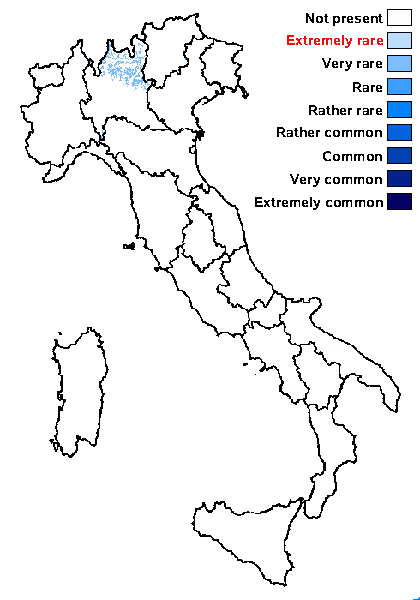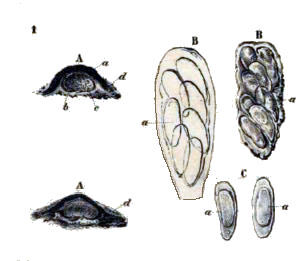Verrucaria aberrans Garov.
Tent. Disp. Lich. Lang.: 11, 1864.
Synonyms:
Distribution: N - Lomb.
Description: Thallus crustose, episubstratic, c. 0.01 mm thick, continuous to finely rimose, dark olive-green to olive-brown, slightly shiny, subgelatinous when wet. Upper layer of cortex colourless; medulla without a black basal layer. Perithecia black, 0.2-0.3 mm across, hemispherically projecting, covered by a thalline layer in lower part. Involucrellum adpressed to exciple, reaching down to maximum half of the perithecium; exciple c. 0.2 mm wide and 1.8 mm high, the wall dark throughout; hamathecium of periphyses and periphysoids, interascal filaments absent; hymenial gel hemiamyloid, I+ red (I+ blue at very low concentrations of I), K/I+ blue. Asci 8-spored, clavate, I-, fissitunicate, the wall thickened above, with an ocular chamber, dehiscent by extrusion of an endotunica to form a delicate rostrum, Verrucaria-type. Ascospores 1-celled, hyaline, oblong-ellipsoid, 14-25(-31) x (9-)11-14 µm. Photobiont chlorococcoid. Spot tests: K-, C-, KC-, P-, UV-. Chemistry: without lichen substances.
Note: a very poorly known silicicolous species, also reported from Germany (Wirth & al. 2010); the type material is from granite in a humid, shaded Castanea-woodland. See also Nimis (1993: 731).
Growth form: Crustose
Substrata: rocks
Photobiont: green algae other than Trentepohlia
Reproductive strategy: mainly sexual
Poorly known taxon in need of further study
Commonnes-rarity: (info)
Alpine belt: absent
Subalpine belt: absent
Oromediterranean belt: absent
Montane belt: very rare
Submediterranean belt: absent
Padanian area: absent
Humid submediterranean belt: absent
Humid mediterranean belt: absent
Dry mediterranean belt: absent

Predictive model
Growth form: Crustose
Substrata: rocks
Photobiont: green algae other than Trentepohlia
Reproductive strategy: mainly sexual
Poorly known taxon in need of further study
Commonnes-rarity: (info)
Alpine belt: absent
Subalpine belt: absent
Oromediterranean belt: absent
Montane belt: very rare
Submediterranean belt: absent
Padanian area: absent
Humid submediterranean belt: absent
Humid mediterranean belt: absent
Dry mediterranean belt: absent

Predictive model
 Index Fungorum
Index Fungorum
 GBIF
GBIF


